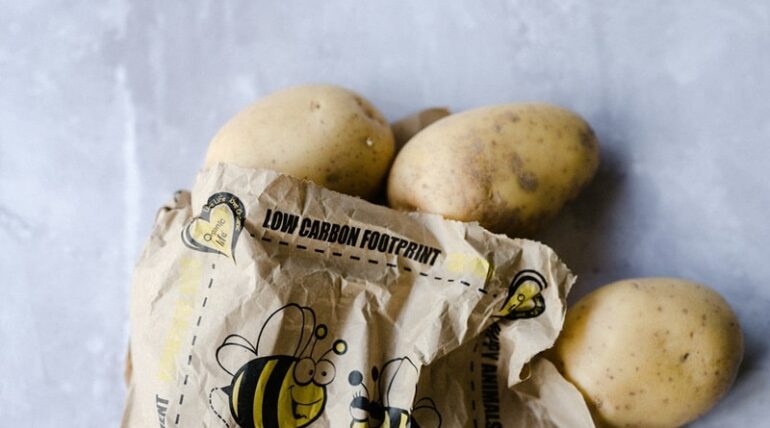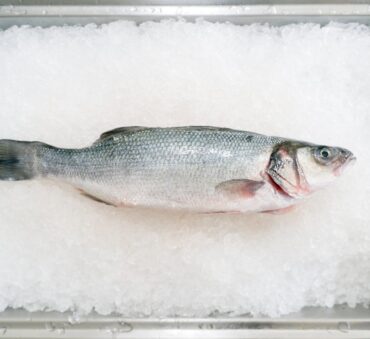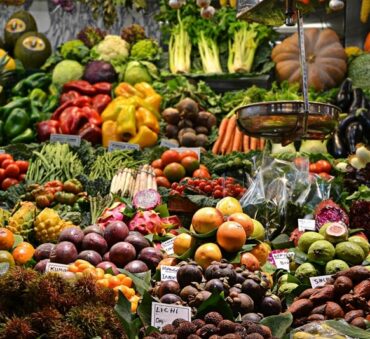Food waste has become a severe issue around the globe, with long-lasting effects on the environment that require immediate attention. Among these is the unfortunate connection between food waste and carbon emissions, a large contributor to global warming and climate change.
From a business perspective, the carbon footprint of food waste is the result of many everyday operations, making it a large concern for companies that want to improve their sustainability efforts and minimize their effect on the environment. So how does food waste contribute to greenhouse gas emissions, and what can businesses do about it?
Keep reading to learn more about the global scale of food waste, the carbon footprint of food production, and strategies to address this growing concern.
Key Takeaways
- The carbon footprint of food waste refers to the total amount of greenhouse gases (GHGs) emitted throughout the entire lifecycle of food. Food waste contributes to GHG emissions in various ways, including the resources used and energy wasted to produce food.
- While energy is used at all stages of the food supply chain, waste becomes more carbon-intensive the further along the chain the food loss occurs. This is because harvesting, transportation, and processing all contribute to food waste greenhouse gases.
- Businesses can calculate GHG emissions by using this formula: GHG emissions = amount of food loss and waste (or activity data) × relevant GHG emission factors. To streamline this process, new technology and tools have emerged.
- Businesses should adopt sustainable practices to reduce their environmental footprint, exploring strategies like upcycling, zero-waste initiatives, improved inventory management, and the use of technology to enhance demand forecasting, among others.
The Scope of Food Waste
Food waste is a multifaceted issue that occurs around the world, in different sectors, and for distinct reasons. Keep reading to better understand the complexity of food waste, demonstrating the need for tailored strategies to minimize its effects.
Global and Regional Statistics
Each year, one-third of the world’s food is wasted, which is equal to 1.3 billion tons of food and $750 billion in economic losses. As a consequence, 28% of the world’s total agricultural area is used to produce food that is lost or wasted. These losses result in environmental, economic, and social consequences alike, with each country facing its own obstacles in addressing the growing crisis.
In the United States alone, food waste is estimated at between 30-40 percent of the food supply, corresponding to approximately 133 billion pounds and $161 billion worth of food. With food waste statistics demonstrating the severity of the problem, the U.S. has set a goal to cut food loss and waste in half by the year 2030.
To reach this goal, many waste reduction strategies have emerged, but improved collaboration and innovative policies and solutions are still required to reduce landfill use, minimize food waste greenhouse gases, and create a more sustainable future.

Food Waste in Different Sectors of the Food Industry
Each sector faces its own unique challenges, contributing to food waste for various reasons, including:
- Manufacturing: 15.3% of all food produced globally is wasted at the farm stage. This is due to overproduction, strict grading and sorting processes, weather and pests, and inefficiencies in harvesting, storage, and transportation.
- Restaurants: Restaurant food waste is often due to over-preparation, inefficient inventory and storage management, large portion sizes, and improper demand forecasting. Every year, U.S. restaurants generate approximately 22 to 33 billion pounds of food waste.
- Hospitality: Food waste in the hospitality industry is also a huge concern, with hotels, restaurants, and cruises all contributing to the issue. Waste in the hospitality sector is often caused by overproduction, inaccurate portion sizes, poor inventory management, and buffet-style dining.
- Fast food: Fast food restaurants generate a large amount of waste due to their operating model, with readily available food making it hard to predict customer demands and leading to overproduction. Aside from junk food waste, packaging waste is also a huge problem throughout this industry.
- Grocery stores: Grocery store food waste is often caused by issues in storage, expiration dates, and stock management. Strict aesthetic standards and marketing techniques also play a role in food waste at the retail level, encouraging wasteful consumer behavior.
Carbon Footprint of Food Waste
The food waste carbon footprint refers to the total amount of greenhouse gases (GHGs) emitted throughout the entire lifecycle of food. Food waste contributes to GHG emissions in various ways, including the resources used and energy wasted to produce food.
The primary landfill gases that are emitted are 40–50% carbon dioxide and 50–60% methane. The remaining landfill gases include nitrogen, oxygen, ammonia, sulfides, hydrogen, and various other gases. According to the Food and Agriculture Organization of the United Nations, if food wastage were a country, it would be the third largest source of greenhouse gas emissions in the world.
Keep reading to learn about the carbon footprint of food products, how food waste in landfills produces methane emissions, and more.
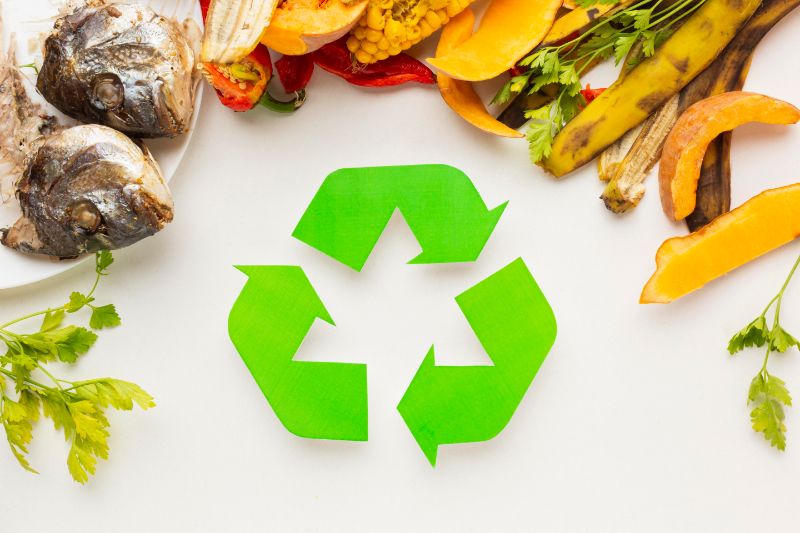
How Food Waste Generates Greenhouse Gases
So how does food waste cause greenhouse gases?
Methane, a powerful greenhouse gas that contributes to global warming, is the result of organic waste decaying over time under anaerobic conditions. Food waste goes through multiple processes before transforming into methane. Initially, microorganisms break down the organic material through hydrolysis. The resulting compounds are then further metabolized to produce acetic acid, and finally, a group of microorganisms called methanogenic archaea converts acetate, hydrogen, and carbon dioxide into methane.
In fact, municipal solid waste landfills are the third-largest source of methane emissions from human activities in the United States, illustrating the need for improved landfill diversion efforts.
Carbon dioxide is also generated from the aerobic and anaerobic decomposition processes in landfills. However, it’s also produced indirectly from the energy used throughout the food cycle, which includes the production, transportation, and handling of food. The EPA estimates that each year, U.S. food loss and waste result in 170 million metric tons of carbon dioxide equivalent GHG emissions (excluding landfill emissions). This is equal to the annual CO2 emissions of 42 coal-fired power plants.
The Carbon Footprint of Different Food Products
The carbon footprint of various foods depends on their unique life cycles. In addition, products may hold different carbon intensities depending on where they are produced, as production techniques vary around the world.
That said, animal-based foods tend to have a higher footprint than plant-based foods. Check out the carbon footprint of foods chart below to see how different products compare.
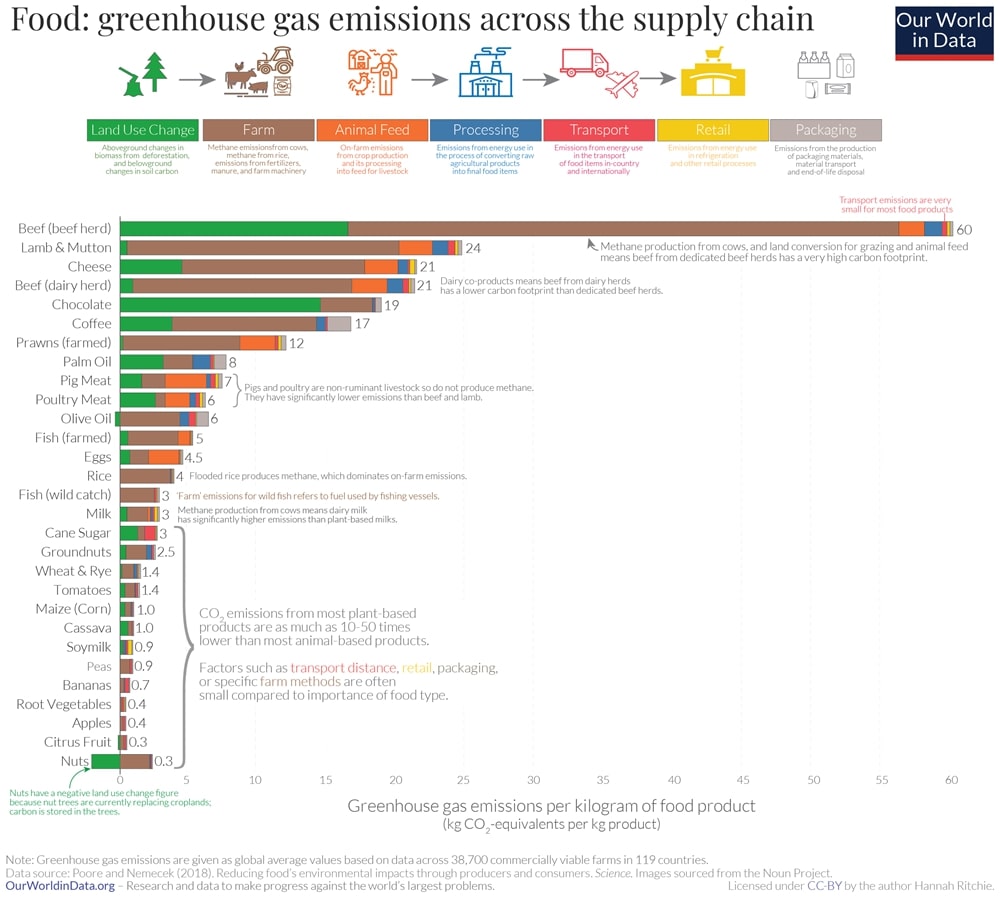
The Carbon Footprint of the Food Supply Chain
As shown in the image above, every stage of the food supply chain, from production to disposal, contributes to the overall carbon footprint. Sources of energy use and carbon emissions include:
- Production: Machinery, fertilizers, deforestation, livestock
- Processing: Machinery and equipment, refrigeration and heating, waste production
- Transportation: Distribution, cold chain logistics
- Storage: Lighting, heating, cooling
- Retail: Refrigeration units, lighting, climate control, excess food waste
- Consumption: Cooking, food storage
While energy is used at all stages of the food supply chain, waste becomes more carbon-intensive the further along the chain the food loss occurs. As explained in this report, a tomato that spoils at the harvesting stage will have a lower carbon footprint than tomato sauce wasted at the retail level due to the harvesting, transportation, and processing that it underwent.
Calculating the Carbon Footprint of Food Waste
By calculating the carbon footprint of food waste, businesses can better understand how their everyday operations affect the environment, helping them create a comprehensive approach to reduce their food waste and carbon emissions. One of the ways companies can do this is by performing a food waste audit, which identifies the amount of waste their company produces, what type of waste, and where in the supply chain it occurs.
Businesses can also calculate GHG emissions by using this formula:
GHG emissions = amount of food loss and waste (or activity data) × relevant GHG emission factors
For a detailed explanation of how to use this formula, read this comprehensive guide: Connecting Food Loss and Waste to Greenhouse Gas Emissions: Guidance for Companies
While this task may seem daunting, new technology and tools have emerged to simplify the process. Businesses can now use food waste technology to reduce waste, maintain detailed records of their carbon emissions from food waste, and monitor their progress.
Impacts of Food Waste Carbon Emissions
Businesses and individuals should be aware of the long-lasting implications of food waste and carbon emissions in order to understand the severity of the issue. Keep reading to explore the environmental, economic, and social consequences of this growing crisis.
Environmental Impact
Natural resource depletion, degradation of land, and loss of biodiversity are only a couple of the environmental impacts of food waste. The carbon emissions from food waste are also a serious issue that must be addressed, affecting the environment in multiple ways.
One of the most significant consequences is the heat-trapping abilities of carbon dioxide and methane, which contribute to global warming and climate change. Increased temperatures and pollution from food waste greenhouse gases also greatly impact air quality and ecosystems.
With both short- and long-term environmental consequences, food waste and carbon emissions have become serious issues in the United States and around the globe, requiring innovative solutions to minimize their effects.
Economic Impact
Since food waste affects everyone along the supply chain, businesses must also consider the severe economic impact of food waste. Globally, around 1.3 billion tons of food each year are wasted, causing economic losses of $750 billion. In the U.S., food waste costs an estimated $218 billion, or 1.3% of GDP, annually.
Aside from the economic losses associated with food items, businesses also lose the resources required to produce products that are never consumed. This includes land, energy, water, and labor.
In addition, businesses that contribute largely to food waste and carbon footprints may also be subject to fines and penalties. Since environmental policies vary depending on location, businesses should consider local regulations and initiatives to ensure compliance.
Social Impact
There are also social consequences of food waste that should not be ignored, such as the global issue of food insecurity. In the United States alone, 44 million people face hunger, yet nutrients and resources are still being wasted in large amounts.
In addition, the environmental and economic consequences of food waste and carbon emissions affect marginalized and low-income communities more than others due to their lack of resources. For this reason, food waste also raises ethical questions about societal values and moral responsibility, compelling businesses and individuals to adopt more sustainable behaviors.

Strategies to Reduce Food Waste and Carbon Footprint
Businesses can reduce food waste and carbon emissions by implementing waste prevention techniques, sustainable practices, and innovative technology. Keep reading to learn about the various approaches that businesses can explore to reduce their environmental footprint.
Waste Prevention Techniques
Reducing food waste at the source should be the top priority for businesses, as it reduces food waste greenhouse gases and provides potential cost savings. Since every business is different, there are various strategies that can be considered depending on your unique needs.
This includes improved inventory management, portion control, proper storage techniques, a comprehensive upcycling strategy, increased food donation efforts, and employee training on food handling. Since food waste overproduction is a large contributor to the issue, improved demand forecasting is an important strategy for many businesses, as it helps match production with actual consumer demand.
As we’ll see below, innovations in technology play a big role in making these waste reduction efforts possible.
Sustainable Practices in the Food Industry
There are a number of sustainable practices that businesses can implement to reduce the carbon footprint of food waste, including:
- Upcycling: Food waste upcycling transforms food items that would otherwise be discarded into new products with higher value. Examples of this include composting, turning waste into animal feed, and biochar production.
- Implementing a circular economy: Food waste in the circular economy focuses on avoiding waste and reusing and regenerating materials or products to preserve their value. This system is based on the 3rs of food waste, which are reduce, reuse, and recycle. By prioritizing these three things, businesses can keep food out of landfills, improve their food waste recycling efforts, and minimize their environmental footprint.
- Zero-waste initiatives: As stated by the EPA, this approach maximizes recycling, minimizes waste, reduces consumption, and ensures that products are made to be reused, repaired, or recycled back into nature or the marketplace. There are many ways that businesses can promote zero waste, such as by improving inventory management and implementing a composting strategy.
- Enhanced packaging: Packaging that meets the specific needs of a food product helps prolong its lifespan, therefore reducing waste at the source. Businesses can now explore sustainable packaging options as well, such as biodegradable packaging and smart packaging equipped with sensors.
Innovations and Emerging Technologies
Emerging technologies and innovations aimed at reducing food waste and its carbon footprint are crucial to making large-scale changes. The advantage of food waste technology is that it has multiple purposes and capabilities, from improved recycling methods to AI-driven waste management systems.
For instance, advanced technologies like anaerobic digestion and thermal conversion are pivotal in transforming food waste to energy. Technology also assists in improved food preservation, with solutions like smart packaging and advanced cold chain technology to reduce waste and improve efficiency during storage and transportation.
AI in food waste management is also becoming increasingly popular for reducing waste and streamlining processes. AI can be leveraged by businesses in various ways, including real-time monitoring, enhanced warehouse management, and the use of predictive analytics to forecast future trends and events.
Conclusion
Food waste greenhouse gases have negative environmental, economic, and social consequences, making waste reduction a high priority in sustainability goals. As businesses start company-wide initiatives to reduce waste, we recommend working with a food waste management company for optimal results.
At Shapiro, we understand that each business and industry face unique challenges and obstacles, which is why we’ll work closely with you to create a tailored food waste reduction plan that meets your specific business needs.
To discuss our organic waste management services, contact us today.
Baily Ramsey, an accomplished marketing specialist, brings a unique blend of anthropological insight and marketing finesse to the digital landscape. Specializing in educational content creation, she creates content for various industries, with a particular interest in environmental initiatives.
